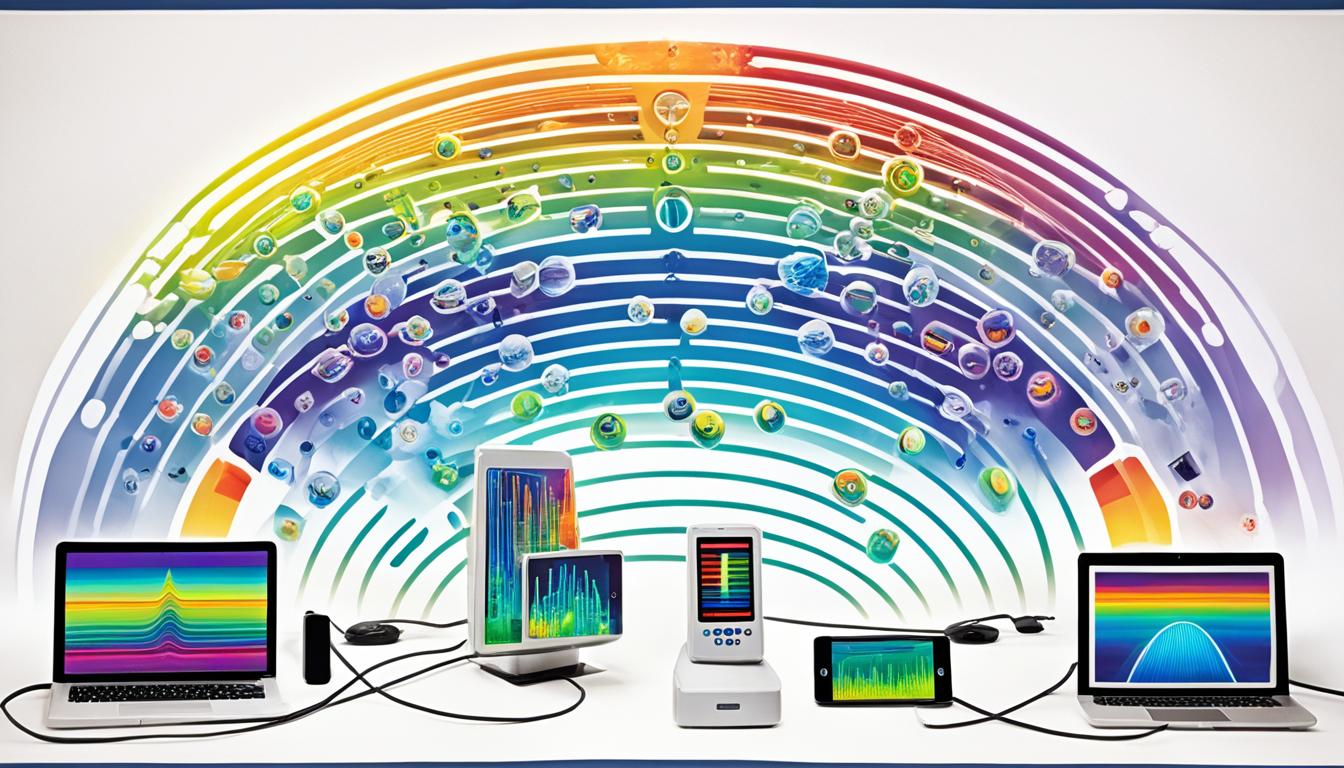Disclosure: This Post Contains Affiliate Links; We earn a commission on purchases.
Electric and magnetic fields (EMFs) are invisible areas of energy that are associated with the use of electrical power and various forms of lighting. EMFs can be categorized into non-ionizing and ionizing radiation. Non-ionizing radiation is generally considered harmless to humans and includes electromagnetic fields produced by low to mid-frequency sources such as power lines, household appliances, and wireless networks. Ionizing radiation, on the other hand, has the potential to cause cellular and DNA damage and includes high-frequency sources like X-rays and gamma rays.
While some studies have suggested a weak association between EMF field strength and increased risk for childhood leukemia, there is currently no conclusive evidence linking EMF exposure to adult cancers like brain cancer, breast cancer, or leukemia. Despite ongoing research, the scientific community has not reached a consensus on the health effects of EMFs.
Key Takeaways:
- Non-ionizing radiation, produced by low to mid-frequency EMFs, is generally considered harmless to human health.
- Ionizing radiation, including high-frequency EMFs, has the potential to cause cellular and DNA damage.
- While a weak association has been suggested between EMF field strength and childhood leukemia, no conclusive evidence links EMF exposure to adult cancers.
As the debate continues, it is essential for individuals to stay informed about the latest research on EMF health effects and take necessary precautions to minimize exposure. In the following sections, we will dive deeper into the understanding of electric and magnetic fields, explore common sources of EMFs, discuss potential health risks, and provide practical tips to reduce exposure.
Understanding Electric and Magnetic Fields
Electric and magnetic fields are invisible areas of energy, or radiation, that are produced by electricity. An electric field is created by voltage, which is the pressure that pushes electrons through a wire. The strength of the electric field increases with higher voltage. Magnetic fields, on the other hand, result from the flow of current through wires or electrical devices and increase in strength as the current increases. Electric fields are present whether a device is turned on or not, while magnetic fields are produced only when current is flowing. When electric and magnetic fields are combined, they form electromagnetic fields (EMFs).
EMFs can be categorized as either non-ionizing or ionizing radiation, depending on their frequency. Non-ionizing radiation, which includes low to mid-frequency EMFs, is not known to directly damage DNA or cells. Ionizing radiation, on the other hand, includes high-frequency EMFs like X-rays and gamma rays, which have the potential to harm cells and DNA.
Electric fields, magnetic fields, non-ionizing radiation, ionizing radiation, EMFs, and electromagnetic fields are key concepts in understanding the nature of energy produced by electricity.
Electric Fields
An electric field is created by voltage, which is the pressure that pushes electrons through a wire. The strength of the electric field increases with higher voltage. Electric fields are present whether a device is turned on or not. They are a fundamental aspect of the energy produced by electricity.
Magnetic Fields
Magnetic fields result from the flow of current through wires or electrical devices. They increase in strength as the current increases. Magnetic fields are produced only when current is flowing. They are an integral part of the energy generated by electricity.
Non-Ionizing and Ionizing Radiation
EMFs can be classified as non-ionizing or ionizing radiation based on their frequency. Non-ionizing radiation includes low to mid-frequency EMFs and is not known to directly damage DNA or cells. Ionizing radiation includes high-frequency EMFs like X-rays and gamma rays, which have the potential to harm cells and DNA.
Understanding the properties of electric and magnetic fields is crucial in comprehending the potential effects of EMF exposure on human health.
Sources of EMFs and Their Frequencies
When it comes to non-ionizing EMFs, there are various sources that we encounter in our daily lives. These sources can be categorized as natural or human-made, each emitting different frequencies of electromagnetic fields. Understanding these sources and frequencies is essential in assessing our potential exposure to EMFs.
Natural Sources
Natural sources of non-ionizing EMFs include the Earth’s magnetic field, which plays a vital role in guiding our compasses and aiding migratory animals. While the Earth’s magnetic field is relatively weak, it is a constant presence in our environment.
Human-Made Sources
Human-made sources of non-ionizing EMFs are more diverse and can be found in our everyday surroundings. Some common sources include:
- Power Lines: Power lines are an essential part of our electrical infrastructure, carrying electricity from generators to our homes and workplaces. They emit low-frequency EMFs, primarily at 60 Hz in North America.
- Electrical Appliances: Common household appliances like refrigerators, washing machines, and hair dryers generate low-frequency EMFs. These appliances are part of our everyday lives and emit EMFs while in use.
- Wireless Telecommunication Devices: Wireless devices, such as cell phones and smart meters, emit non-ionizing EMFs in the form of radio waves and microwaves. These devices have become an integral part of modern communication and are prevalent in today’s society.
Cell phones, in particular, operate within a specific frequency range. In the United States, cell phones typically operate between 1.8 and 2.2 GHz, emitting radiofrequency radiation.
Additionally, other human-made sources of non-ionizing EMFs include radio and television signals, radar installations, satellite stations, and medical devices like magnetic resonance imaging (MRI) machines. These sources emit radio waves and microwaves, each with specific frequency ranges.
It’s important to note that the exposure to EMFs decreases as we increase our distance from the source. Maintaining a safe distance can help reduce our overall exposure levels.
In summary, the sources of non-ionizing EMFs are varied, ranging from power lines and electrical appliances to wireless telecommunication devices. Understanding the frequencies emitted by these sources allows us to assess our potential exposure and make informed decisions about our daily lives.
EMF Exposure and Health Risks
While there have been ongoing concerns about the potential health effects of EMF exposure, the scientific evidence linking EMFs to adverse health effects remains inconclusive.
The research conducted during the 1990s focused on extremely low-frequency EMF exposures from conventional power sources and suggested a weak association between EMF field strength and childhood leukemia. However, studies on adults have not shown evidence of a link between EMF exposure and adult cancers like brain cancer, breast cancer, or leukemia.
The use of cell phones, which emit radiofrequency radiation, has also been a subject of investigation. Current scientific evidence has not definitively linked cell phone use with adverse human health problems, although more research is needed to further understand any potential risks.
It is important to note that the strength of an EMF decreases significantly with increasing distance from the source.
In summary, while the health risks associated with EMF exposure remain uncertain, current research does not provide conclusive evidence of a direct link between EMFs and adverse health effects such as adult cancers. However, it is recommended to stay informed about ongoing studies and take practical measures to reduce exposure to EMFs, especially in proximity to high-frequency sources like power lines and by practicing responsible cell phone usage.
Practical Ways to Reduce EMF Exposures
While the potential health risks of EMF exposure are still uncertain, it is important for individuals to take practical measures to reduce their exposure to electromagnetic fields. By implementing these simple strategies, you can minimize your exposure and promote EMF safety:
- Limit cell phone usage: Keep your cell phone usage to a minimum and utilize hands-free options whenever possible. This reduces your proximity to the device and decreases your exposure to electromagnetic radiation.
- Use speakerphone or wired headsets: When making calls, opt for the speakerphone function or use a wired headset. By keeping the phone away from your head, you can minimize direct exposure to EMFs.
- Keep cell phones away from your body: Especially during sleep, it’s essential to keep your cell phone away from your body. Place it on a nightstand or in another room to reduce your exposure while resting.
- Limit use of wireless devices: Reduce your use of wireless devices such as tablets and laptops. When using them, ensure you are in an area with good signal strength to avoid excessive EMF exposure.
- Avoid prolonged exposure to high-frequency EMFs: Maintain a safe distance from sources of high-frequency EMFs, such as power lines. Increasing the distance between yourself and the EMF source decreases your exposure.
- Consider using EMF shields or covers: While the effectiveness of these devices is debated, some individuals choose to utilize shields or covers that claim to reduce EMF exposure.
- Follow safety guidelines provided by manufacturers: Manufacturers often provide safety guidelines for household appliances and electronic devices. Ensure you follow these guidelines to minimize EMF exposure.
- Stay informed about current research: Stay up-to-date with the latest research on EMF health effects. As new evidence emerges, adapt your safety practices accordingly.
By implementing these EMF reduction tips, you can take proactive steps towards minimizing your exposure and promoting a safe environment.
Understanding the Difference Between Non-Ionizing and Ionizing EMFs
When it comes to electromagnetic fields (EMFs), it’s important to understand that not all types of EMFs have the same impact on our health. EMFs can be categorized into two main types: non-ionizing and ionizing EMFs.
Non-Ionizing EMFs
Non-ionizing EMFs are low to mid-frequency EMFs that are generally considered harmless to humans. These EMFs are produced by various sources like power lines, household appliances, and wireless networks. Non-ionizing EMFs are not known to directly damage DNA or cells in the human body.

Ionizing EMFs
On the other hand, ionizing EMFs have the potential to cause cellular and DNA damage. These EMFs are high-frequency and include X-rays and gamma rays. Unlike non-ionizing EMFs, ionizing EMFs can harm cells and DNA.
While studies have suggested a possible weak link between EMF field strength and increased risk for childhood leukemia, the evidence linking ionizing EMFs to adult cancers like brain cancer, breast cancer, or leukemia is limited.
It is important to note that the debate among researchers regarding the potential health risks of EMF radiation exposure is ongoing. Further studies are needed to fully understand the effects of both non-ionizing and ionizing EMFs on human health.
EMFs and Cancer Risk
The potential link between EMF exposure and cancer, including childhood leukemia, has been the subject of extensive research. Studies conducted during the 1990s suggested a weak association between EMF field strength and an increased risk of childhood leukemia, but the evidence remains inconclusive. Although further research is needed to establish a definitive causal relationship, studies on adults have not shown evidence of a link between EMF exposure and adult cancers such as brain cancer and breast cancer.
Despite the ongoing debate in the scientific community, it is essential to note that the majority of research does not support a strong connection between EMFs and cancer. It is crucial to interpret the findings with caution and consider the overall body of evidence.
“While studies have suggested a possible link between EMF field strength and childhood leukemia, the evidence remains inconclusive.”
The potential carcinogenic effects of EMF exposure, particularly in relation to childhood leukemia, require further investigation. Researchers are actively conducting studies to understand the mechanisms underlying EMF interaction with biological tissues and to evaluate the long-term risks of EMF exposure. It is important to continue monitoring the latest research developments in this area and take necessary precautions, especially for vulnerable populations such as children.
While the scientific community awaits more conclusive evidence, individuals can adopt a precautionary approach by reducing their overall EMF exposure. This can be achieved by practicing safe habits, such as limiting cell phone usage, maintaining a safe distance from high-frequency EMF sources like power lines, and following manufacturer safety guidelines for household appliances. By staying informed and implementing simple measures, individuals can minimize their potential risks associated with EMF exposure.
| EMF and Cancer Risk Factors | |
|---|---|
| Childhood Leukemia | Inconclusive evidence of a weak association with EMF exposure |
| Brain Cancer | No evidence of a link to EMF exposure |
| Breast Cancer | No evidence of a link to EMF exposure |
EMF Safety Concerns
In light of mounting concerns surrounding the potential health effects of EMF exposure, many organizations and individuals are adopting a precautionary approach to minimize their exposure to electromagnetic fields. This proactive stance involves taking practical measures to reduce EMF exposure, even in the absence of definitive scientific evidence regarding the extent of its health risks.
Recognizing the need to establish guidelines and exposure limits for EMFs, various countries and international organizations have implemented safety measures based on current scientific knowledge. These guidelines serve to inform the public about the potential risks associated with EMF exposure and provide recommendations on how to minimize it.
It is crucial for individuals to stay informed about the latest EMF safety guidelines and follow any recommendations provided by reputable sources, such as government agencies and health organizations. By staying up to date with EMF exposure guidelines, individuals can make informed decisions and implement effective strategies to protect themselves and their families.
The Precautionary Approach to EMFs
The precautionary approach to EMFs stems from the understanding that while there may be uncertainties surrounding the long-term health effects of EMF exposure, taking proactive steps to reduce exposure can help mitigate potential risks. By adopting this approach, individuals can prioritize their well-being and that of their loved ones.
While ongoing research continues to shed light on the potential health risks associated with EMF exposure, the precautionary approach acknowledges the importance of taking preventive measures to limit risks, especially when it comes to prolonged and close-range exposure to sources such as power lines, wireless devices, and household appliances.
“It is better to be safe than sorry. By implementing simple precautionary measures, individuals can reduce their EMF exposure and potentially lower their risk of any associated health concerns.”
EMF Exposure Guidelines
EMF exposure guidelines provide valuable insights into the recommended limits for safe exposure to electromagnetic radiation. These guidelines are designed to be protective and are based on scientific research and expert consensus. They offer practical advice on how to reduce EMF exposure in various settings, including homes, workplaces, and public spaces.
Some key recommendations from EMF exposure guidelines include:
- Maintaining a safe distance from high-frequency EMF sources, such as power lines and electrical substations.
- Using hands-free options like speakerphones or wired headsets when using cell phones.
- Avoiding sleeping near electronic devices, especially wireless routers and alarm clocks.
- Reducing the use of wireless devices and opting for wired connections whenever possible.
- Following manufacturer’s safety guidelines for household appliances and electronic devices.
By adhering to these guidelines, individuals can make informed choices about their daily habits and effectively minimize their exposure to EMFs, thus promoting their overall well-being.
Implementing a Precautionary Approach for EMF Safety
It is important to adopt a precautionary approach to EMFs, considering the potential health concerns associated with long-term exposure. By taking proactive steps to reduce exposure and following established guidelines, individuals can safeguard themselves and their families against potential risks.
While the extent of the health effects of EMF exposure remains a topic of ongoing research and debate, adopting a precautionary approach allows individuals to prioritize their well-being and reduce potential risks. By staying informed about EMF safety guidelines and implementing practical measures to limit exposure, individuals can cultivate a healthier environment for themselves and future generations.
| Benefits of the Precautionary Approach to EMFs | Practical Steps for EMF Safety |
|---|---|
| – Reduces potential health risks – Promotes peace of mind – Enables proactive lifestyle choices | – Use wired connections when possible – Keep a safe distance from EMF sources – Follow safety guidelines for devices – Stay informed about EMF safety guidelines |

Current EMF Health Effects Research
As the use of EMF-emitting devices continues to rise in daily life, ongoing research is being conducted to deepen our understanding of the potential health effects of EMF exposure. Scientists and researchers are investigating various aspects of EMFs, including their impact on cellular function, DNA damage, and the potential development of chronic diseases. This research aims to provide valuable insights into the long-term effects of EMF exposure on human health.
Staying updated on the latest EMF research findings is crucial for individuals to make informed decisions about their exposure and take necessary precautions. By remaining aware of the ongoing EMF studies, individuals can ensure they are equipped with the most up-to-date knowledge regarding the potential health risks associated with EMF exposure.
The Importance of Ongoing EMF Studies
Ongoing EMF research plays a vital role in exploring the potential health effects of EMF exposure. Here are some key reasons why ongoing studies are significant:
- Advancing scientific knowledge: Ongoing research helps to advance our scientific understanding of how EMFs interact with biological systems. By studying the effects of EMFs on cellular function and DNA, researchers can uncover valuable insights that contribute to our understanding of EMF health effects.
- Identifying potential risks: Continuous research allows scientists to identify and assess any potential risks associated with EMF exposure. By examining the long-term effects of EMFs, researchers can determine whether there are any links between EMF exposure and the development of chronic diseases.
- Informing public health guidelines: Findings from ongoing EMF studies can inform the development of public health guidelines and recommendations. By incorporating the latest research, policymakers and regulatory bodies can provide evidence-based guidance to individuals and communities.
- Promoting safety measures: Ongoing EMF research helps to identify effective safety measures and strategies for reducing EMF exposure. By understanding the potential health risks, individuals can take appropriate steps to mitigate their exposure and minimize any potential negative effects.
Recent EMF Research Updates
Here are some notable recent updates from the field of EMF health effects research:
| Date | Research Topic | Key Findings |
|---|---|---|
| 2021 | Effects of EMFs on sleep quality | Preliminary studies suggest a potential link between high EMF exposure during sleep and disrupted sleep patterns. Further research is needed to establish a conclusive relationship. |
| 2020 | EMFs and neurodevelopmental disorders in children | Initial findings indicate a possible association between EMF exposure and an increased risk of neurodevelopmental disorders in children. Further research is underway to confirm these findings and explore potential underlying mechanisms. |
| 2019 | Long-term effects of EMF exposure on cognitive function | Early studies suggest a potential link between chronic EMF exposure and cognitive decline in older individuals. Further research is required to establish a definitive relationship and understand the underlying mechanisms. |
It is important to note that while these recent findings provide valuable insights, further research is necessary to confirm and build upon these preliminary results.
“Ongoing EMF research plays a crucial role in expanding our knowledge of the potential health effects of EMF exposure. By staying informed about the latest research findings, individuals can make informed decisions and take necessary steps to mitigate any potential risks.”
— Dr. Emily Cooper, EMF Researcher
EMF Exposure and Daily Life Considerations
EMF exposure is a part of our daily lives, as there are various sources of electromagnetic fields (EMFs) present in our homes and workplaces. It is important to be aware of these sources and implement strategies to reduce our exposure to EMFs.
One common source of EMFs is power lines, which emit high-frequency fields. To minimize exposure, it is advisable to keep a safe distance from power lines whenever possible.
Another significant source of EMFs is the use of wireless devices such as cell phones. Limiting cell phone usage and using wired headsets or speakerphones can help reduce EMF exposure from these devices.
Additionally, it is crucial to follow manufacturer safety guidelines for household appliances and electronic devices. These guidelines often include recommendations on how to position and use these devices to minimize EMF exposure.
By being aware of the potential sources of EMFs in our daily lives and taking practical steps to reduce exposure, we can create a healthier environment for ourselves and our loved ones.
Conclusion
The potential health effects of EMF exposure have been a subject of ongoing research and discussion. While some studies have suggested a weak association between EMF field strength and increased risk for childhood leukemia, there is currently no strong evidence linking EMF exposure to adult cancers such as brain cancer, breast cancer, or leukemia. The scientific community recognizes the need for further research to better understand the potential risks and to develop comprehensive safety guidelines.
In the meantime, individuals can take practical steps to reduce their exposure to EMFs. This includes limiting the use of wireless devices, such as cell phones and tablets, using wired headsets or speakerphones, keeping a safe distance from high-frequency EMF sources like power lines, and following manufacturer safety guidelines for household appliances and electronic devices. By staying informed about new developments in EMF health effects research, individuals can make informed decisions and take necessary precautions to create a healthier environment.
It is important to note that while the potential health effects of EMF exposure continue to be investigated, neither the scientific community nor regulatory bodies have established conclusive evidence of significant risks to human health associated with non-ionizing EMFs. Nevertheless, it is always good practice to stay informed, implement practical strategies to minimize exposure, and prioritize safety in our daily lives.
Source Links
- https://www.niehs.nih.gov/health/topics/agents/emf
- https://www.betterhealth.vic.gov.au/health/healthyliving/electromagnetic-fields-emf-and-health-issues
- https://www.cancer.gov/about-cancer/causes-prevention/risk/radiation/electromagnetic-fields-fact-sheet

Subscribe to Our Newsletter










